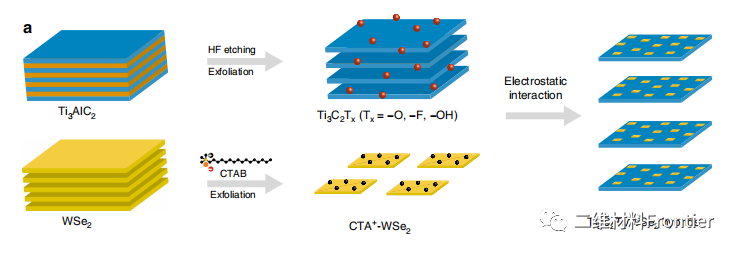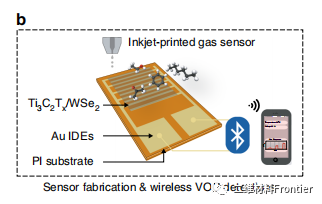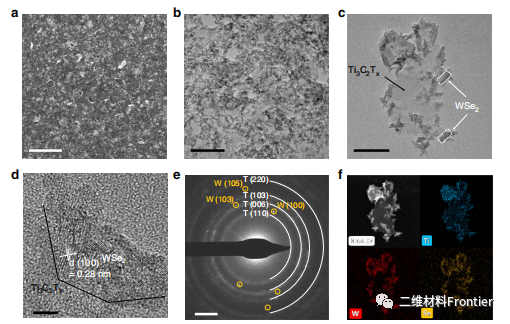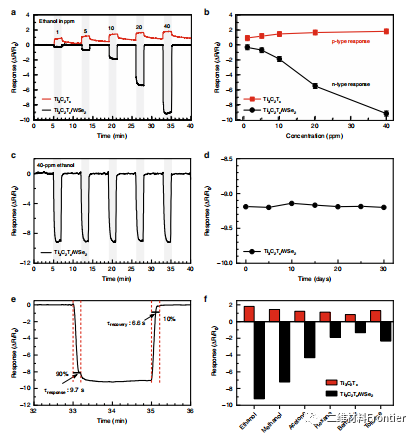
hotline£º
17715390137
Tel/Wechat£º
18101240246 (Technology)
0512-68565571
Email£ºmxenes@163.com £¨Sales Engineer£©bkxc.bonnie@gmail.com
Scan the code to follow or search the official account on WeChat:
2D Materials Fronrier After paying attention,
click on the lower right corner to contact us,
Enter enterprise WeChat.
Professional Services Online

I. Overview of the article.
Two-dimensional transition metal carbide / nitride, known as MXenes, has recently received attention in the field of gas sensing. However, at present, there are relatively few studies on the hybrid of MXenes and 2D transition metal sulfides as gas sensing materials. In this paper, it is reported that Ti3C2Tx and WSe2 are selected as hybrid model materials for the detection of various volatile organic compounds. The Ti3C2Tx/WSe2 hybrid sensor has low noise level, ultra-fast response / recovery time, and good flexibility for a variety of volatile organic compounds. The hybrid process provides an effective strategy for anti-oxidation of Ti3C2Tx by limiting the interaction of water molecules at the edge of MXene. In this paper, an enhancement mechanism of Ti3C2Tx/WSe2 heterostructure materials is proposed, which can be used to detect oxygen-containing volatile organic compounds with high sensitivity and selectivity. The scientific findings of this study could guide future exploration of the next generation of deployable sensors.
II.Guided reading of picture and text.

Fig. 1. Schematic diagram of the preparation process of Ti3C2Tx/WSe2 nanohybrids.

Figure 2. A schematic diagram for the detection of volatile organic compounds with a wireless monitoring system.

Fig. 3. Microstructure analysis of Ti3C2Tx/WSe2 nanocomposites.
(a).
SEM image of Ti3C2Tx/WSe2 nano-mixed film (scale, 2 ¦Ì m).
(b).
TEM images of Ti3C2Tx/WSe2 nanocomposites at low magnification (scale, 200nm).
(c).
Displays an image of a single Ti3C2Tx/WSe2 nanocomposite material (scale, 100 nm).
(d).
High resolution TEM images (scale, 100nm) of Ti3C2Tx/WSe2 nanocomposites.
(e).
The selected region electron diffraction pattern (scale, 2nm-1) of Ti3C2Tx/WSe2 nanocomposites.
(f).
The HAADFSTEM images of Ti3C2Tx/WSe2 nanocomposites and the corresponding element mapping show the uniform decoration of WSe2 nanosheets on the Ti3C2Tx matrix.

Figure 4. The sensing characteristics of the sensor.
(a).
Ti3C2Tx and Ti3C2Tx/WSe2 gas sensors respond in real time to ethanol exposure with concentrations ranging from 1 to 40ppm.
(b).
Gas response of Ti3C2Tx and Ti3C2Tx/WSe2 sensors under the action of ethanol gas concentration.
(c).
Cycle performance of Ti3C2Tx/WSe2 gas sensor when ethanol concentration is 40ppm.
(d).
Long-term response stability of Ti3C2Tx/WSe2 sensor under 40ppm ethanol for one month.
(e).
The reaction and recovery time of 40ppm ethanol was calculated.
(f).
Selectivity test of Ti3C2Tx and Ti3C2Tx/WSe2 sensors under different volatile organic compounds of 40ppm.
III. Summary of the full text.
This paper reports that Ti3C2Tx/WSe2 nanocomposites, manufactured by surface treatment and exfoliation, are used as sensing materials in inkjet printing and wireless operation sensors for the detection of various volatile organic compounds at room temperature. Compared with the sensors made by the original Ti3C2Tx and the original WSe2, the Ti3C2Tx/WSe2 hybrid sensor improves 12 times in terms of ethanol sensitivity, low electrical noise, sound selectivity and ultra-fast response / recovery performance. In addition, the study also illustrates the hybrid of MXenes and TMDs as sensing materials, which overcomes the instability and oxidation trend of a single MXenes, and thus becomes a method to promote the practical application of MXene materials. Therefore, the flexible sensor reported in this paper has high application potential. It is expected that the hybrid method of this work will be extended to the sensing applications of other two-dimensional MXene materials.
This information is from the Internet for academic exchange only. if there is any infringement, please contact us to delete it immediately.

| Reminder: Beijing Beike New Material Technology Co., Ltd. supplies products only for scientific research, not for humans |
| All rights reserved © 2019 beijing beike new material Technology Co., Ltd ¾©ICP±¸16054715-2ºÅ |